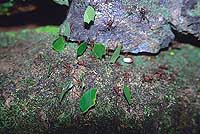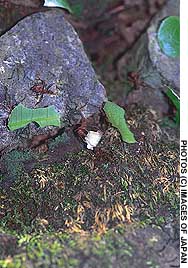The ants' workaday world is wherever you look
By Mark Brazil | Jun 20, 2002
Despite the name, I didn’t see any ants in Antarctica, though it’s the only place I’ve been that I haven’t seen any. Everywhere else, from Alaska to Australia, from Norway to New Zealand, I have encountered them. Ants are an extraordinarily numerous and successful group.Beneath the feet of human commuters scurrying between home and work, work and home, is another commuting horde in miniature. It is all too easy to crush them by the dozen with one foot or to eradicate a colony with a few puffs of poisonous powder, but these fascinating diminutive creatures perform some outsized services.
Take a closer look. Even a cursory inspection of your garden, the parking area near your apartment, the local park or the sidewalk on the way to the station will reveal that in any one area, several species are involved. To the untrained eye they all look similar, but you’ll soon notice that while some are dark shades of red or brown, others are virtually black.
Species in abundance
Soon you will also notice that there are considerable size variations between species. Tiny, barely visible ants are but a fraction of the size of the larger species. And if you extend your ant foray further, to the nearest hills, fields, plantations or forests, you’ll add yet more species to your growing ant list.
Due to Japan’s considerable climatic variation from north to south, there is a plethora of species to be found here. I located several ant colonies during my five-minute walk from home to the nearest station. Ant columns were disappearing down pencil-size holes in cracks in the paving, the holes surrounded by small heaps of excavated grains of sand. Hidden beneath the concrete were the galleries and corridors of their nests.
The ant trails are used to carry food to the nest: crumbs, fragments, tiny gleanings of edible waste; they benefit from our wasteful lifestyles, and we benefit from them cleaning up some of our mess.
They also scavenge and forage for other insects and small creatures, cleaning up and recycling the nutrients in many habitats. While mice and rats are our commonest mammalian scavengers, and black kites our commonest avian scavengers, we owe far more to the Lilliputian waste-disposal department staffed by ants.
Ant biologists (myrmecologists) have some fascinating species to study, and their names alone are intriguing (or alarming, depending on your frame of mind): driver ants, army ants and, my favorite — the horticulturalist of the bunch — leaf-cutter ants.
These are the cultivators of their tribe, cutting leaf sections and carrying them home to farm edible fungi on beds of leaf compost.
Scent highway of life
Ant tasks are herculean. When traveling, I struggle with a duffel bag only one-quarter my own weight, but ants will pick up and carry objects larger and heavier than they are, dragging or lifting them over barriers as they relentlessly follow the pheromone trails of their brethren. This chemical scent trail is crucial.
Sight is insignificant; the scent line is both highway and lifeline, for it leads out to food and back to home. An ant that strays may become lost; one that strays into another colony’s domain may launch both colonies into ant wars. To put their prodigious efforts into perspective, imagine that you are at work, using your jaws to chew futon-size pieces from the nearest wall, then — still using only your jaws — you raise the whole piece over your back and set off to walk home.
The concept seems mind-boggling, but leaf-cutter ants do the equivalent, day in and day out. They cut large pieces from the vegetation of their forest habitat and carry them home to their colony.
Ants are social insects that live in colonies of thousands of individuals ruled as a matriarchal monarchy. The life cycle of the average ant is marked by four very different stages that involve a complete metamorphosis from egg to larva, then to pupa and finally to adult.
But not all adults are equal; there are three kinds. The largest individual in the colony is the queen. Queens have the distinction of being the only females that reproduce. They decide on the nest site, and they lay all the eggs.
In contrast to the long-lived and privileged queens, males have only a brief role in the life of the colony. They live only to fertilize the queen, and they usually die within just a few days of mating. The third group of adults consists of the extraordinarily numerous worker ants. These are the ones we typically see scurrying and gathering, and in lines commuting back to their colony. The workers are, in fact, sterile females.
Female warriors
Just as ant individuals go through various phases, so too do ant colonies. First comes the founding stage, when the new queen locates her nest and establishes a new colony. Next comes a period of exponential growth, when the size of the colony and the number of workers explodes.
Finally there is the mature stage, during which many of the workers are occupied with tasks in and around the nest, such as caring for the queen and her developing young, excavating new tunnels and keeping existing tunnels clean. Meanwhile, the older workers, the oldest of the sterile females, are the ones venturing outside to forage and defend the nest. So ant wars are fought between the colonies’ oldest females.
Ants are armored — theirs is an exoskeleton — like a medieval knight kitted out for battle, but with his muscles connected to the armor instead of to internal bones.
Ants are highly specialized insects, and scientists who study them have an array of unfamiliar terms to describe even their basic body parts (alitrunk, propodeum and gaster, for example), because their bodies do not correspond directly to those of other insects.
Regardless of their names, the segmented, waisted form of the average ant gives it tremendous flexibility and mobility, particularly in enclosed spaces.
So before you stamp down on those scurrying hordes, spare a thought for these wonders of nature. Their antics are well-worth exploring. Many of even the commonest ants remain poorly known, and many secrets remain to be discovered — perhaps even among ants you pass every day on your way to work.


